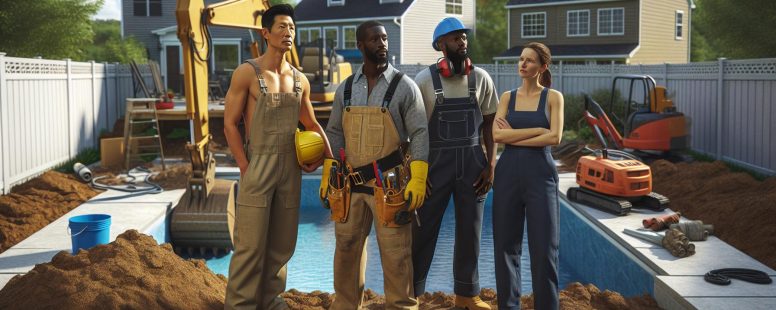Understanding Your Pool Build: Timeframes and Key Steps Detailed
Understanding Pool Building Timelines
Making the decision to install a pool is an exciting one, but it also raises the question most homeowners grapple with – how long does it take to get it all done? A myriad of factors contribute to the timeline for pool building. From the type of pool you’re installing to unexpected delays, understanding the key elements can help set expectations and ensure satisfaction at the end of the process.
Factors That Affect Construction Time
First off, let’s discuss the biggest influencers on a construction timeline. Permits acquisition, the size, and shape of your pool, as well as weather disruptions, all play significant roles.
- Permit Acquisition: Before the actual construction begins, you’ll need relevant permits. The time taken to obtain these permits varies by area, with some places approving within weeks while others could take up to a couple of months.
- Size and Shape of The Pool: Larger or uniquely shaped pools require more time for construction as compared to their small, regular-shaped counterparts.
- Weather Disruptions: Outdoor construction, like pool building, is susceptible to weather disruptions. Harsh weather conditions, such as heavy rain or snow, can delay the process significantly.
Remember, setbacks aren’t uncommon during construction. Hence, it’s essential to factor in potential delays when estimating the pool construction timeline.
Different Types of Pools and Associated Timelines
Diving deeper, it’s important to know that the type of pool you choose will also affect the construction timeline. Here are three common types of pools and their general timelines:
- Vinyl Liner Pools: These are typically the fastest to construct, often taking around 2 to 5 weeks. The swift timeline stems from the fact that vinyl liners are easier to install than other materials such as concrete or fiberglass.
- Fiberglass Pools: Pre-made in factories, fiberglass pools require around 3 to 6 weeks for construction. The time factor here often ties to the shipping and ground preparation required for installation.
- Concrete Pools: Offering the most customizability, concrete pools sport the longest construction timeline – often between 3 to 6 months. The lengthy timeline is due to the time needed for the concrete to cure between steps.
By understanding these factors and timelines, you can better anticipate the construction process of your new pool. Just as every backyard is unique, so too is every pool construction project. Patience, planning, and clear communication with your contractor pave the way to an end product you’ll enjoy for years to come.
Pre-Construction Considerations
Before a shovel hits the ground, there are numerous elements in play that determine how long it takes to build a pool. These preliminary considerations can significantly impact the timeline and are influenced by important factors such as permit approvals and design planning.
Securing Permits and Approvals
Securing permits and approvals might seem like a clerical task, but it plays a pivotal role in your pool construction timeline. Mostly, local authorities dictate the rules for pool construction, with each region having its own set of regulations and guidelines.
Obtaining permits constitutes two major components – reviewing the pool design by the governing body and conducting field inspections to ensure conformity with local safety standards. For instance, localities in California can take up to 4 weeks for permit approvals, while those in Texas might only need two. The variance depends largely on the locality’s workload and efficiency; so, factor this in while planning.
Design and Planning Phase
Designing and planning, a creative yet technical phase, acts as the blueprint for your pool. Complexity and detail in the design significantly influence the time taken in this phase.
Common stages include initial consultation, concept development, final design approval, and engineer review. An elaborate, custom-designed pool with features like waterfalls, a spa, or a pool house necessitates extensive planning and could range from 4 to 6 weeks. A basic, minimalist pool, on the other hand, hastens the process, lowering the design phase to approximately 2 weeks.
Remember, throughout these pre-construction stages, cooperation and open communication with your contractor are crucial. These steps lay the groundwork, eventually dictating the smoothness and efficiency with which the rest of your pool construction process proceeds.
Main Phases of Pool Construction
After meticulous planning and design, there come the crucial stages essential to pool construction. The main phases of building a pool can be categorized under three broad headings: Excavation and Framing, Plumbing and Electrical installation, and Pool Lining and Finishing.
Excavation and Framing
In the first step, the area identified for the pool gets sculpted. With machinery or manual labor, landscaping experts shape your yard, carving the ground to form the pool’s skeleton. It typically takes about 1 to 2 weeks for this phase, depending on ground hardness and accessibility of the site.
Post excavation, steel reinforcement bars, commonly referred to as rebars, are installed. These sturdy rods form the pool’s frame, enhancing the structural integrity, giving the pool its long-lasting strength. This steel framework construction roughly consumes a week.
Plumbing and Electrical Installation
The next phase involves running the plumbing lines and electrical installation. It’s not just about getting water in and out of your pool – there are filters to consider, heating elements, and perhaps even water features or jacuzzi jets. Plumbing professionals install pipes, secure them, and make sure everything seamlessly connects in your circulation system.
Simultaneously, electricians work on the system’s wiring, ensuring all electrical components, from lighting to heaters, comply with local safety regulations.
These installations demand meticulous precision, taking about two weeks for complete setup. Note, these estimates vary based on the complexity of pool designs and incorporating additional features.
Pool Lining and Finishing
After ensuring plumbing and electrical systems are in place and working appropriately, pool construction reaches the final phases. For concrete pools, the interior gets a layer of gunite or shotcrete, forming a robust shell. This shell then needs to cure typically for about a week or so.
A neat finish is the final step transforming this structure into your dream pool. Plaster, vinyl liners, or aggregates like pebbles or glass beads are options one can consider to enhance the pool’s cosmetic appeal while ensuring longevity. This process normally requires around 1 to 3 weeks, with extra time for the pool to fill and for any final adjustments.
Remember, while these durations offer a general guide, actual timelines can vary. Factors such as the pool’s size and complexity, extra features, regional regulations, and even the weather can influence the time it takes. Building a pool – it’s all about the planning, the process, and the people involved in creating the perfect backyard oasis.
Important Post-Construction Steps
After finalizing the main phases of pool construction, it’s not time to relax just yet. There are certain important post-construction procedures that require your attention. These involve specific tasks such as filling and chemical treatment along with landscaping and decoration of surrounding areas.
Filling and Chemical Treatment
Once your pool’s lining and finishing phase is complete, the next step involves filling the pool with water. It typically takes 1 to 2 days to fill a standard pool of 20,000 gallons. This timeframe, but, may vary based on water pressure and pool dimensions. After the pool is filled, it’s time for the chemical treatment, an essential step for maintaining the cleanliness and overall health of the pool. This usually takes 2 to 3 days, depending on the initial water conditions. So, all told, this whole process might require about 4 to 6 days for completion.
During this phase, you will establish your pool’s initial chemical balance. Begin by testing the pH, alkalinity, and calcium hardness levels of the water. For instance, the ideal pH should land between 7.2 to 7.6, while the recommended level for alkalinity is in the range of 80 to 120 parts per million (ppm). Calcium hardness, on the other hand, should be in the area of 200 to 400 ppm.
Landscaping and Surrounding Areas
The final step in the pool-building process typically takes the most time to conclude. It includes landscaping and beautification of the space surrounding the pool. The duration of this stage can vary greatly, highly dependent on the complexity of your plans. You may want to incorporate a simple deck or you may opt for a luxurious outdoor lounge, complete with pavilion, kitchen, and fire pit – choices that will indeed affect the overall timeline.
During landscaping, you’ll focus on enhancing the appeal of your backyard, incorporating elements such as walkways, patios, lighting, and more. For example, adding a basic concrete patio might take 1 to 2 weeks, while more elaborate layouts involving decking and built-in kitchens could stretch to a month or longer.
Bear in mind, even though this being the final step, it’s also one that continuously evolves. A well-landscaped backyard takes into account seasonal shifts, plant growth, and maintenance requirements. So, anticipate ongoing involvement in appreciating and maintaining this aspect of your new pool environment.
In essence, the construction of a swimming pool is not simply about digging a hole and filling it with water. Each phase, from excavation to landscaping, plays a crucial role. Understanding these steps allows you to manage this significant project effectively, ensuring a smooth development process and a fantastic final result.
Conclusion
So, you’ve journeyed through the ins and outs of pool construction. It’s clear that building a pool isn’t a one-size-fits-all process. From excavation to landscaping, every stage plays a crucial role in determining how long it’ll take to build your dream pool. Remember, the size and complexity of your pool can significantly impact the timeline. And don’t forget about those post-construction steps. Achieving the perfect chemical balance for your pool is a must, and it takes time. As for landscaping, it’s the cherry on top that wraps up the project, but it too requires ongoing care. All in all, understanding each phase can help you manage the project effectively and ensure a successful outcome. Now, you’re well-equipped with the knowledge to begin on your pool-building journey. Immerse!
- When Is Peak Season for Hot Tub Rentals in the US? Find Out Best Times to Book - November 10, 2025
- Where Can I Market My Yard Game Rentals? Top Strategies to Boost Your Business - November 10, 2025
- Why Is Microgreens Farming Popular for Small Spaces? Top Benefits Explained - November 9, 2025




